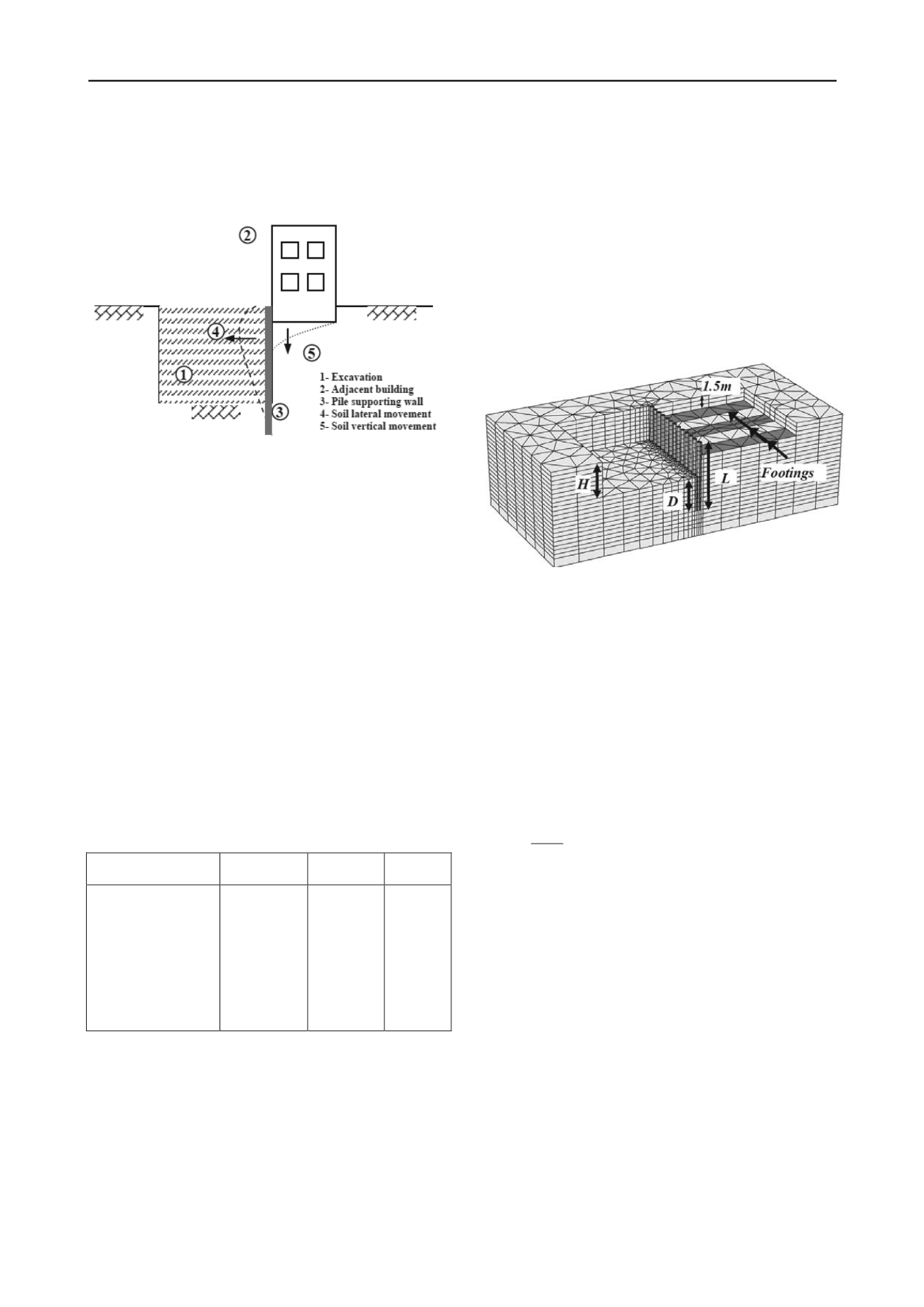
2836
Proceedings of the 18
th
International Conference on Soil Mechanics and Geotechnical Engineering, Paris 2013
The foundation level was assumed to be at 1.5 m depth from the
ground surface. The mesh was generated as fine mesh at piles
where the stresses are expected to be high. Coarse mesh was
used at the boundaries of the model where the stresses are low.
Figure 1. Problem under study
2.2
Soil modeling
Soil is assumed to be a deposit of clay. Fifteen node triangular
element was used to model the soil. Soil material was assumed
to behave as an elastic perfectly plastic material following
Mohr-Coulomb model. The soil parameters are presented in
Table 1.
2.3
Pile and foundation modeling
Piles were modeled as a massive circular concrete pile. Pile
Young’s modulus (
E
) was 2.1 x 10
7
kPa. Both pile diameters (
d
)
of 0.3 m and 0.4 m was considered in the study. They have
flexural stiffness (
EI
) of 8350 kN.m
2
and 26390 kN.m
2
respectively.
The adjacent building foundation is modeled as plate of
thickness of 0.5 m. Foundation was idealized with six nodes
triangular plate element in the analysis. Interface element was
used to represent the contact between plate elements and soil.
Table 1. Clay input parameters in FEM
Parameter
Soft to
Medium Clay
Medium
Clay
Unit
Dry unit weight,
γ
d
Wet unit weight,
γ
wet
Young’s modulus,
E
s
Poisson’s ratio, υ
Undrained cohesion, c
u
Friction angle, φ
Dilatancy angle, ψ
Interface reduction
factor, R
18
20
4000
0.3
25
12
0
1
18
20
8000
0.3
50
14
0
1
kN/m
3
kN/m
3
kN/m
2
-
kN/m
2
degree
degree
-------
2.4
Analysis procedure
The variable parameters used in the analysis are the excavation
height (
H
), pile embedded depth (
D
), and pile diameter (
d
) as
shown in Fig. (2). Also, both soft to medium clay and medium
clay soil were used in the analysis. Pile diameter was assumed
to be 0.3 m and 0.4 m with spacing of pile diameter between
pile edges.
The analysis was carried out in steps. The first step was
applying the stress of the adjacent building at the foundation
level without the pile wall and the excavation. The second step
was activation of the pile wall in the soil. The third step was the
excavation of the soil.
In the present paper, only bending moment of pile and pile
lateral displacement outputs were used in the analysis. All the
presented results are of the pile at the middle of the supporting
wall. It was found from the results that this pile is the most
critical in both lateral deflection and bending moment. The piles
at the ends of the wall have the lowest lateral deflection and
bending moment profiles. The stress on the foundation level
was assumed to be 100 kN/m
2
. This stress is corresponding to a
bearing capacity factor of safety of 2 for the soft to medium clay
case.
Figure 2. FEM geometry and meshing
3 FEM RESULTS AND DISCUSSIONS
3.1
Effect of supporting excavation
Excavation height (
H
) and cohesion of clay (
c
u
) are two main
parameters in the design of the pile wall. It was found that
results should better be related to a factor has both the effect of
excavation height (
H
) and undrained soil shear strength (
c
u
).
The stability factor (
N
c
) joins both
H
and
c
u
parameters in the
following relationship as recommended by Polous and Chen
(1996):
u
c
c
H N
(1)
where
γ
is the unit weight of the soil.
Figure (3) shows lateral displacement profile (
U
x
) versus
depth (
Z
). Both the profile of unsupported soil lateral
displacement and pile lateral deflection are shown in Fig. (3).
Large soil movement can be observed due to the stress of the
adjacent building in the case of unsupported excavation. The
lateral displacement increases rapidly as the excavation height
increases. Maximum lateral displacement increased from about
0.06 m to 0.2 m when
N
c
increased from 1.9 to 3.2. However,
the maximum lateral displacement increased to very large value
of 1.2 m for
N
c
= 4.5. This means that the excavation is failed at
N
c
= 4.5. When the excavation is supported using contiguous
pile wall, soil movement decreases in the zone above the
excavation level. However, below the excavation level, there is
no obvious decrease in soil movement. It should be noted that in
all cases the pile wall is translated horizontally.
3.2
Effect of excavation height
Pile wall lateral deflection increases as excavation height (
H
) or
the stability factor (
N
c
) increases. As
N
c
increases pile wall
movement changes from translation (
H
=3 m) to both


